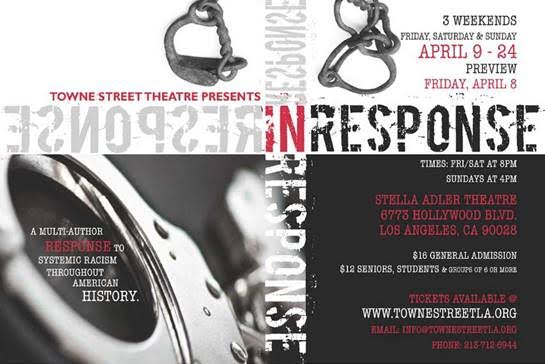
Towne Street Theater, L.A.’s premiere African-American theatre company, has thrown all its resources behind In Response, a multi-media show which it premiered last Fall on the 48th anniversary of the assassination of Dr. Martin Luther King, Jr. and the 24th anniversary of the Los Angeles riots. Thanks to audience demand, TST reprises it for a limited run at the Stella Adler Theater. A potpourri of short plays, spoken-word, video and song, In Response was triggered by the recent spate of police shootings and violent attacks on unarmed black men and women. The Black Lives Matter movement has a prominent position in the show, whose historical roots lead back to slavery and the Civil War. Some two dozen actors, backed up at times by video projection, give voice to the feelings, thoughts and demands of African-American people down through the ages, with an emphasis on the hope and promise for the future of race relations in the USA. A few famous writers are quoted in the show—notably Claude McKay and George Moses Horton—but for the most part, In Response was written by such company members as Barbara White-Morgan, Ken Cosby, and Vincent Terrell Durham. Working in a variety of styles, these writers contribute original sketches which hammer away at the pernicious effects of racism on the soul of this country. A lot of anger and resentment is justifiably expressed in such sketches as “A Mother’s Cry” (women bemoaning the loss of sons to slavery) and “Insert the Bullets” (coming to grips with America’s gun culture. That’s not to say, though, that In Response is devoid of humor or satire. “70s Time Trippin” uses humor, disco and rap to poke fun at racist police, and in “The Escape,” a young black girl desperate to escape the Confederate south does so by dressing up like a young white boy. The show’s 22 scenes take place on Nathaniel Bellamy’s simple but evocative set; and while the show could benefit from trimming and tightening, there is no denying its professionalism, importance and power.
